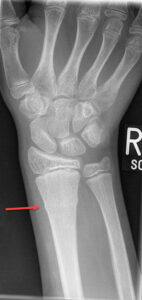
A torus is the convex portion of the upper part of the base of a Greek column and resembles the appearance of the cortical buckling seen in the "column" of bone which has been fractured in the pattern discussed in this article. The term torus is the Latin word meaning protuberance. Sometimes a cast may be applied, but often a splint is all that is required with a period of rest and immobilization. Salter-Harris fractures are classified into 5 types according to the extent of damage to the growth plate and joint involvement. These fractures only arise in children and adolescents, whose skeletal growth is not yet complete. They are self-limiting and typically do not require operative intervention, although a manipulation may be required if the angulation is severe. are fractures of the epiphyseal plate, also known as the growth plate or the physis of long bones. in some cases, angulation is the only diagnostic clue.subtle deformity or buckle of the cortex may be evident.This most commonly occurs at the distal radius or tibia following a fall on an outstretched arm the force is transmitted from carpus to the distal radius and the point of least resistance fractures, usually the dorsal cortex of the distal radius. PathologyĬortical buckle fractures occur when there is axial loading of a long bone. There has been a single case report of a torus fracture of the distal radius in an adult 9.

In adults, the commonest form of buckle fracture by far is a buckle fracture of the ribs. These type of fractures are more common in children, especially aged 5-10 years, due to the elasticity of their bones. Rarely, a torus fracture may refer to the fracture of an oral torus, and there is potential for the two terms to be confused 10. However, the terms are often used interchangeably. These injuries require rigid immobilization and orthopedic consultation.Strictly speaking, a torus fracture refers to a circumferential buckle fracture 7. Radiographs should be scrutinized for other diagnoses since minimally displaced greenstick and Salter–Harris II fractures of the distal radius may be mistaken for buckle fractures 6. One side of a bone bends, raising a little buckle, without breaking the other. The key caveat is to ensure that the radiological diagnosis of distal radius buckle fracture is correct. What Is a Buckle Fracture A buckle (or torus) fracture is a type of broken bone. 3,5,6 An orthopedic surgeon should be consulted if the child’s condition is not improving over time or the child has not fully recovered by six weeks. Follow-up with an orthopedic surgeon is not routinely necessary and these children can be safely followed up with a primary care physician.
#Buckle fracture free#
2 Activities that could lead to re-injury should be avoided until the child has been free of symptoms for two weeks (about 6-8 weeks from time of injury). Most children use the splint regularly for two to three weeks and about 99% are fully recovered by four weeks.

The duration of splint use and return to play should be guided primarily by pain and the degree of buckle fracture noted on the x-rays. Treatment with immobilization with a removable splint is used as needed to reduce pain and to protect against re-injury. 4 Further, these RCT’s demonstrated that parents and families preferred the removable splint, and splinting was found to be more cost-effective for the health care system. 2,3 Data from eight randomized control trials conducted in the UK, Canada and the US has demonstrated that treatment with a removable splint is at least as effective as a short arm cast with respect to recovery of physical function.

The cosmetic and functional prognosis of this fracture is excellent even if it associated with an ulnar buckle/styloid fracture. What is a buckle fracture Your child has suffered a ‘buckle’ fracture of their arm and wrist. 1įigure 1: Buckle Fracture of the Distal Radius Distal Radius Buckle Fracturesīuckle fractures of the distal radius represent about 50% of pediatric fractures of the wrist. This article reviews the evidence that recommends that management of the distal radius buckle fracture. Since these fractures are stable and have an excellent prognosis, they do not need to be routinely immobilized in a cast nor followed by an orthopedic surgeon. The dogmas of the past are now being challenged for the most common minor pediatric fractures, distal radius buckle fractures and minor distal fibular fractures.


 0 kommentar(er)
0 kommentar(er)
